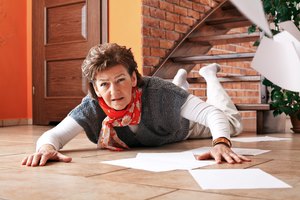Fall Prevention at Home

September 18–24 is National Falls Prevention Awareness Week. Every year the National Council on Aging (NCOA), the national voice for every person’s right to age well, sponsors this national health campaign with the goal of increasing awareness around preventing falls and injuries.
Six out of 10 falls happen at home; many are due to hazardous home conditions. Here’s a rundown on how to reduce the risk of falls at home by increasing safety.
Bedrooms
Light is essential to reducing the risk of falling, especially when getting out of bed while still sleepy. Night lights can be a great help if they are close to the bed. Switches for other lighting should be within arm’s reach of the bed. Also, store a flashlight near the bed in case the power goes out. Finally, have a well-charged cell phone or a landline near the bed in case help is required.
Bathrooms
Grab bars are safety devices designed to aid people with balance. Mounting grab bars inside and outside of the bathtub or shower can provide extra help when moving. Installing grab bars near the toilet is also a good idea for assisting with getting up and down. For surfaces that get wet, make sure nonskid mats, strips, or carpets are used to prevent slipping. And like the bedroom, a night light is a good idea – especially for those late-night bathroom visits.
Kitchen
Storing frequently used kitchen items like pots and pans in easy-to-reach places can ensure easy and safe access. If a spill occurs, clean it up immediately. And if preparation is going to take a long time, consider preparing the food while seated; this will prevent fatigue, which can lead to balance loss.
Stairways, hallways, and floors
For stairs, ensure there are handrails on both sides. Using the handrails, even when carrying items, can help maintain balance. Again, lighting is important. There should be switches and the top and bottom of the stairs or at both ends of a long hallway. Keep stairs and floors clean of items so accidental tripping doesn’t happen. Any carpets should be firmly fixed to the floor; no-slip strips are easily available and can prevent carpets from moving. Refrain from using smaller throw or area rugs. And if a floor has been recently mopped, stay off it until it’s dry.
Outdoors
Maintain stairs and walkways so they don’t become broken or uneven; consider adding non-slip material on stairs to make it easier for feet to “grip” while moving. Clean debris off as soon as possible. When ice or snow is present treat surfaces with sand or some other ice melt product. Lights should be left on a night or on a sensor, particularly if people will be arriving after sunset. A grab bar near the door can help with balance while locking or unlocking the door.
For a personalized risk assessment, NCOA offers an online check-up here. “Falling is not a normal part of aging, and it can be prevented,” said Kathleen Cameron, senior director of NCOA’s Center for Healthy Aging. “We believe it is a team effort to empower all older adults to reduce their risk.”
Sources: IlluminAge Communication Partners with information from NIH and NCOA.
![Family Home Health [logo]](https://www.familyhomehealthnetwork.com/wp-content/uploads/sites/250/2017/04/logo-new.png)